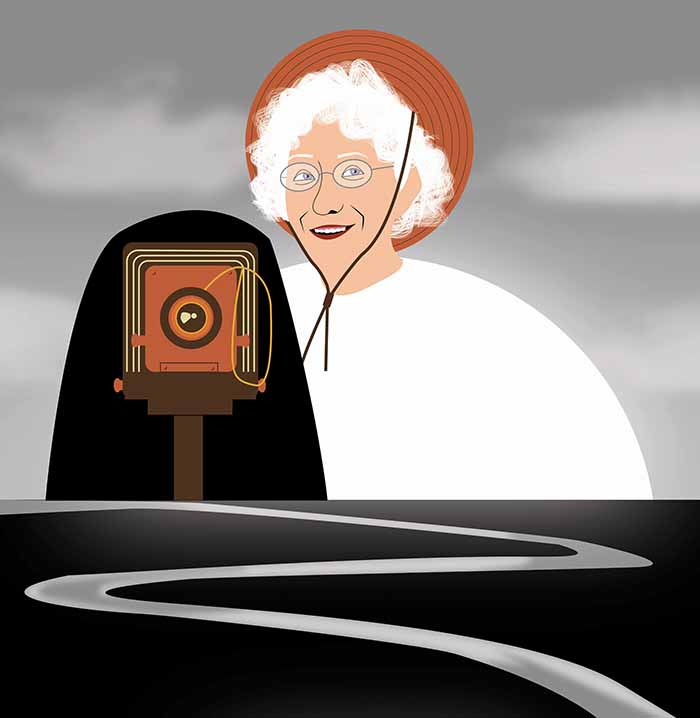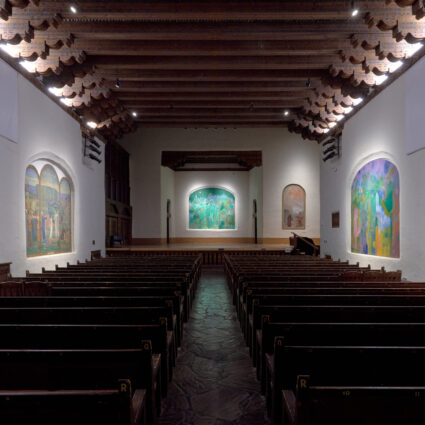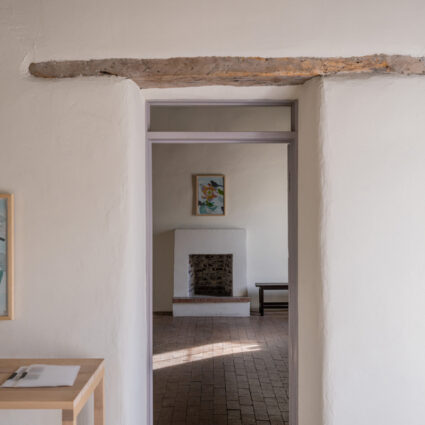
Name: Laura Gilpin
Born: Austin Bluffs, CO, 1891
Died: Santa Fe, NM
Role: Photographer, lesbian
Known for: One of the only female landscape photographers of her era
Quote: “It is the principal reason I live in the west. I…am willing to drive many miles, expose a lot of film, wait untold hours, camp out to be somewhere at sunrise, make many return trips to get what I am after.”
Laura Gilpin saw the landscape of the Southwest as a constitutive element of the human cultures that formed there. Among the few women artists who took active part in landscape photography in the early and mid-twentieth century, Gilpin’s photos stand out against the pristine emptiness of Ansel Adams and the surveying explorations of William Henry Jackson for their engagement with the land as it acted on and was acted upon by people. She moved to Santa Fe to work on her book, Rio Grande: River of Destiny (1949), and stayed for the rest of her life. For the book, she photographed the entire length of the Rio Grande, yet the bulk of the photos show how communities have grown and sustained themselves alongside the river. She called it “a portrait of the river,” which documents agricultural and irrigation practices and shows what types of plants and food the river makes possible. She also captured a historic two-year drought, another facet of living in the river’s sway. Her photos and her writing offer an insightful recognition of the inseparability of human beings from their environment. She refused to depict the environment without also documenting human impact upon it.
Like so many of the Santa Fe women I’ve researched, Gilpin was determined to practice her art and engage directly with the landscape of the Southwest.
Gilpin began taking photographs with a Brownie camera when she was twelve. She is best known for her book, The Enduring Navaho (1968), which came about after she and her lifelong partner Elizabeth Forster got a flat tire near Red Rock, AZ, where Forster was working as a field nurse in a Navajo community. (Gilpin’s mother had hired Forster as a nurse to help Gilpin convalesce when she was ill with influenza in her twenties, and the two spent the rest of their lives together.) She and Forster returned to the area years later, camera in tow. Gilpin opens her book, “Within the boundaries of their 25,000-square-mile reservation, more than 100,000 Navaho People, the largest tribe of Indians in North America, are striving for existence on a land not productive enough to sustain their increasing population.” She was staunchly aware of the U.S. government’s role in the destruction of Native lands and communities, and states this outright. Her photos of the Navajo include candid portraits of individuals, mostly women, who face the camera without stiffness or pretension. She documented weaving, cooking, and other everyday practices, and offered those who sat for photos a small fee or a copy of the photo. Unlike other photographers who approached Indigenous people with an anthropological gaze, Gilpin’s photos include clothing and objects that attest to the influence of Anglo culture and products, like soft drink bottles and denim jackets. The postures and facial expressions of the people she photographed suggest a family album more than formal portraiture. She wasn’t trying to suggest a separation between the Navajo and other people, but to emphasize a larger connection.
Gilpin, like many female artists, struggled to support herself and her work for most of her life. Sent to boarding school on the East Coast when she was a teen, she had to return to Colorado when her father went into debt. Twice she started her own poultry farms: first to get her father afloat and later, with Forster, to support themselves. Money from the sale of her first turkey farm put her through the Clarence H. White School in New York, where she studied photography and began making hand-coated platinum paper, a practice she continued through the 1970s. Eventually, Gilpin went to work for Boeing, where she photographed pin-up girls and dignitaries and learned to shoot photos from airplanes in flight, a skill she drew on when photographing the Rio Grande. It’s not unusual for women artists, lesbian artists especially, to struggle for recognition and support. Landscape photography was a male-dominated sphere, and Gilpin’s incorporation of portraiture, interiors, and buildings didn’t fit with the nature-as-blank-canvas aesthetic of early photographers in the West.
Like so many of the Santa Fe women I’ve researched, Gilpin was determined to practice her art and engage directly with the landscape of the Southwest. Whether it required turkey farming or death-defying flight above the Rio Grande in threatening weather, she was unstoppable.



